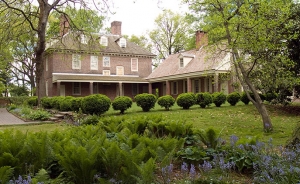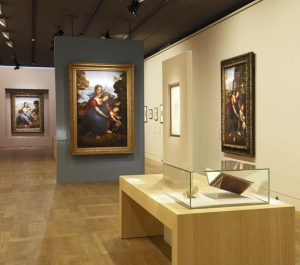|
Displaying items by tag: workshop

In conjunction with Stenton’s exhibition, LOGANIA: Stenton Collections Reassembled, Stenton has brought together known Logan family Queen Anne chairs and comparable examples from public and private collections. This lecture and workshop will provide a close study of chairs that may appear the same or very similar on the outside, but are structurally different on the inside. Why these differences? Where did they come from? What do they tell us about chair making in Colonial Philadelphia? Join us at Stenton on Friday April 17th for this special workshop exploring Queen Anne chairs and their construction. Workshop will be led by Laura Keim, Stenton’s Curator, and Philip Zimmerman, Scholar and Decorative Arts Consultant. Tickets are Required.
Ticket prices are $50 for General Admission, $45 for Friends of Stenton or NSCDA/PA members. Fee includes buffet lunch. Please email This email address is being protected from spambots. You need JavaScript enabled to view it. or call 215-329-7312 for more information or for reservations.
Jeff Koons is ramping up operations at his high-tech stone workshop in Morrisville, Pennsylvania, where his sculptures are carved almost entirely by machines. This suggests that the artist may be developing new bodies of work in the medium. Since opening Antiquity Stone in 2012, Koons has more than tripled its production capacity; it now has 12 computer-operated stone-cutting machines, two robots and around 30 employees. The facility, which exists solely to fabricate Koons’s work, now bills itself as “the most advanced stone fabrication operation in the world”, according to a job advertisement it posted in January, seeking a supervisor for its Computer Numerical Control (CNC) machines.

Glassmaking originated around 2500 B.C. in Mesopotamia, and by the mid-first millennium B.C. it had spread throughout the ancient world. The number of vessels made from glass remained limited, however, until the introduction of two important technical advances—the use of the blowpipe and closed multipart molds—in the late first century B.C. and the early first century A.D., respectively. These advances revolutionized the glass industry under the Roman Empire, making glass vessels accessible to all and allowing producers to create a wide range of shapes, sizes, and usages. Some of the earliest vessels made by mold blowing bear the names of the craftsmen who “signed” the molds.
In the early first century A.D. the most outstanding examples of Roman mold-blown glass were made by a craftsman called Ennion, and products of his workshop are the focus of the exhibition "Ennion: Master of Roman Glass," at The Metropolitan Museum of Art. This is the first exhibition of ancient glass organized by the Metropolitan, which has one of the finest collections of this material in the world.
The 18th-century cabinetmaker Nathaniel Gould left inkblots in his battered gray notebooks as he recorded the luxurious mahogany output of his workshop in Salem, Mass. His listings of clients and fees, found seven years ago in forgotten boxes at the Massachusetts Historical Society in Boston, have enabled researchers to attribute his mostly unsigned antiques. Next weekend, about 20 of these pieces will go on view at the Peabody Essex Museum in Salem in the exhibition “In Plain Sight: Discovering the Furniture of Nathaniel Gould.”
The show’s catalog blends tragic family lore with statistics. Gould’s clients lost their furniture in fires, their fortunes in bankruptcies and war and their family members in shipwrecks. Coffins for children were among his workshop’s frequent commissions.
The Madoura Pottery in Vallauris, Southern France, is crumbling down. According to the Journal du Dimanche (JDD), the workshop Picasso used to produce some of his best-known ceramic work is in a dire state. The walls are saturated with water. There’s a hole in the roof.
Living in Vallauris between 1946 and 1955, the Spanish giant embraced ceramics with gusto, and over 9,000 pieces came out of Madoura between 1947 and 1971, many of which are now fetching top prices at auction.

Christie’s London will offer a Rococo coffee-pot by Paul de Lamerie (1688-1751), the most celebrated British silversmith of the 18th century, as part of its Exceptional Sale on July 4, 2013. The George II silver coffee-pot, which was commissioned in 1738 by a wealthy London-based merchant, is expected to become the most valuable piece of English silver ever to be sold at auction. The masterpiece was recently the highlight of a British silver exhibition at the Metropolitan Museum of Art in New York.
Lamerie, who began his career in 1703 as an apprentice to the London goldsmith, Pierre Platel (1659-1739), opened his own workshop in 1713 and was soon appointed goldsmith to George I. His work evolved from simple Queen Anne styles to classical French designs, but his ornate Rococo works of the 1730s are his most admired pieces. Lamerie’s illustrious clientele included Sir Robert Walpole, King John V of Portugal, and Queen Elizabeth II, who he made a wedding gift for.
The coffee-pot heading to auction in July is expected to garner approximately $4.5 million.

Genre-defying painter, sculptor, and illustrator, Richard Artschwager (1923-2013), died February 9, 2013 in Albany, NY. He was 89.
Artschwager, who was often linked to the Pop Art movement, Conceptual Art, and Minimalism, resisted classification through his clever genre mixing. His most well known sculpture, Table with Pink Tablecloth (1964) is an amalgamation of Pop Art and Minimalism and consists of a box finished in colored Formica, creating the illusion of a wooden table draped in a pink tablecloth. Artschwager often used household forms in his work including chairs, tables, and doors. In his paintings, Artschwager often painted black and white copies of found photographs and then outfitted them with outlandish frames made of painted wood, Formica or polished metal.
Artschwager was born in 1926 in Washington, D.C. and went on to study at Cornell University. In 1944, before he could finish his degree, he was drafted into the Army and sent to Europe. Upon returning to the United States after World War II, Artschwager completed his degree and decided to pursue a career in art. He moved to New York City and began taking classes at the Studio School of the painter Amédée Ozenfant, one of the founders of Purism. With a growing family and bills to pay, Artschwager took a break from making art to start a furniture-making business. After a fire destroyed his workshop, Artschwager returned to making art, developed his defining style, and was taken on by the Leo Castelli Gallery, which represented him for 30 years.
A few days prior to Artschwager’s death, the Whitney Museum of American Art in Manhattan closed a major career retrospective of his work. It was the second of its kind to be organized by the museum.

Leonardo da Vinci’s (1452-1519) Virgin and Child with Saint Anne currently resides in the Louvre’s illustrious collection in Paris. Last year, the painting was the highlight of an exhibition at the French institution, which included compositional sketches, preparatory drawings, and landscape studies as well as related works by other artists. The work even made an appearance at the Louvre’s outpost in Lens, an industrial town in northern France. Considered his final masterpiece, da Vinci worked on Virgin and Child with Saint Anne for years, ultimately leaving the painting unfinished at the time of his death in 1519.
The J. Paul Getty Museum in Los Angeles recently put a different version of the painting on view. The work, which appeared in the Louvre’s exhibition, was made in da Vinci’s workshop, but not by his hand. It will remain on view with the museum’s Italian Renaissance paintings indefinitely.
The painting was bequeathed to UCLA in 1939 by California real estate developer Willitts J. Hole. The work was transferred to the Hammer Museum in 1995 after the university took over management and operation of the institution. Sadly, Virgin Child with Saint Anne has spent decades in storage. In fact, it hasn’t been prominently displayed since the 1940s when it hung in the UCLA library. The reason the work has languished in storage for so long is that the Hammer Gallery requires that any work displayed in its historical art galleries be a part of founder Armand Hammer’s personal collection. Since Virgin and Child with Saint Anne was a gift, it doesn’t qualify.
The painting arrived at the Getty in 2010 prior to being shipped to Paris for the Louvre exhibition. Museum staff analyzed, cleaned, and repaired some varnish before shipping the painting to Europe. Now that Virgin and Child with Saint Anne is back at the Getty, museum officials are happy to have the work on public display.

On view through January 27, 2013 at the Metropolitan Museum of Art in New York, Extravagant Inventions: The Princely Furniture of the Roentgen’s is the first comprehensive exhibition to focus on the Roentgen family’s cabinetmaking firm, which operated from 1742 into the early 1800s. Extravagant Inventions presents around sixty pieces of furniture, many of which have never been seen outside of Europe.
Abraham Roentgen (1711-1793) and his son David (1743-1807) were pioneering figures in 18th century Continental furnituremaking. Based in Germany, the Roentgen firm’s style is characterized by opulence, inventiveness (they often incorporated hidden compartments and secret drawers into their works), and ornate, finely carved shapes. The Roentgens served clients around Europe including France’s Louis XVI and Marie Antoinette and Russia’s Catherine the Great.
Extravagant Inventions brings together works from various international collections as well as six works from the Met’s own holdings. Highlights include a writing desk (circa 1758-1762) designed by Abraham Roentgen and considered one of the greatest creations from his workshop, a mechanical secretary cabinet (1779) made for King Friedrich Wilhelm II of Prussia, and a pair of marquetry portraits (1775-1780) depicting a man and a woman, which exemplifies the marquetry technique the Roentgens were renowned for.
|
|
|
|
|